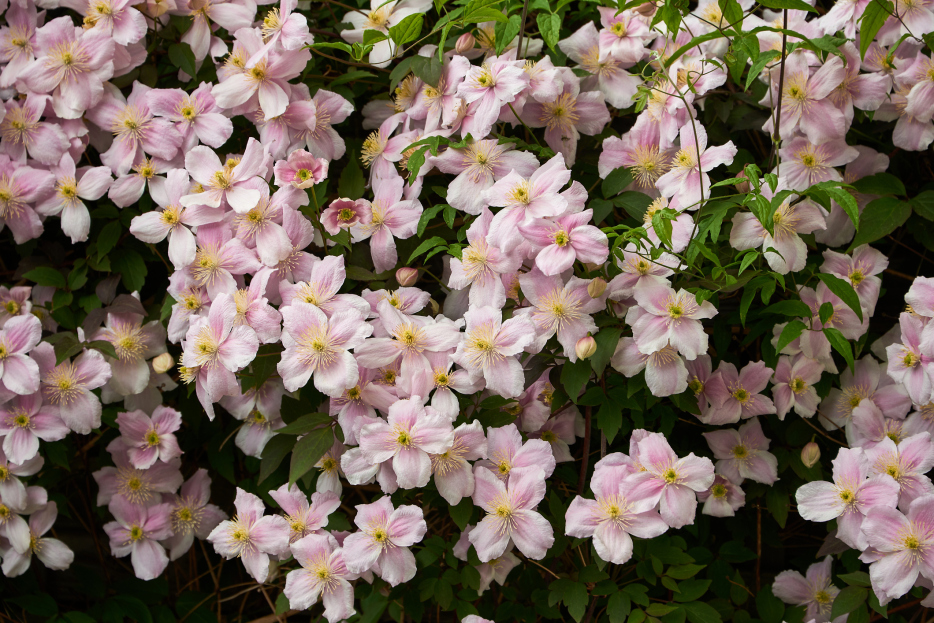
Clematis, often referred to as the "queen of climbing plants," is a stunning, versatile vine that adds vibrant colors and beautiful blooms to any garden. Whether grown on a trellis, fence, or in containers, they are a popular choice for gardeners who want to add a touch of elegance and charm. However, to ensure your clematis thrives and produces abundant flowers, proper care is essential. Here’s everything you need to know about caring for this gorgeous plant.
Clematis plants love full sun and need at least 6 hours of direct sunlight per day to bloom profusely. A sunny spot encourages strong growth and vibrant flowers. However, while clematis loves the sun, it’s important to protect the roots from excessive heat. You can do this by providing some shade to the base of the plant using mulch, ground covers, or low-growing companion plants. This helps keep the roots cool while allowing the vines to soak up the sun.
If you’re growing clematis in a more shaded area, choose varieties that are tolerant of partial shade. While they may not bloom as abundantly as those in full sun, they can still thrive in a slightly shaded environment.
Clematis thrives in well-draining soil that is rich in organic matter. It prefers soil that is slightly acidic to neutral, with a pH level between 6.0 and 7.0. Before planting clematis, improve your soil by adding compost or organic matter to ensure good drainage and nutrition. Heavy clay soils should be amended with sand or organic matter to prevent waterlogging.
When planting, dig a hole that is wide enough to accommodate the root ball, and ensure that the soil is loose and well-aerated. Clematis roots dislike sitting in water, so good drainage is essential for preventing root rot.
Clematis plants prefer consistently moist, but not waterlogged soil. Regular watering is essential, especially during dry spells, but you should avoid letting the soil become soggy. Water deeply to encourage the roots to grow deep into the soil, but make sure the soil drains well after watering.
Water your clematis at the base of the plant to keep the foliage dry, as wet leaves can lead to fungal diseases. During the hot summer months, you may need to water more frequently, especially if your clematis is in full sun.
Clematis plants thrive in moderate temperatures, ideally between 60°F and 75°F (15°C to 24°C). While they can tolerate heat, they will benefit from some protection during the hottest part of the day, especially in warmer climates. If you live in a hot area, consider planting your clematis on a north-facing wall or in a spot that gets afternoon shade.
Clematis generally prefers moderate humidity levels, and it does best in areas with good air circulation. In very humid climates, make sure the plant has adequate space to breathe and avoid overcrowding, as poor air circulation can promote fungal diseases.
Fertilizing clematis is important for encouraging strong growth and abundant blooms. Feed your clematis once in early spring as new growth begins, using a balanced, slow-release fertilizer. Look for a fertilizer that is low in nitrogen and high in phosphorus and potassium, as these nutrients promote flowering and root development. Avoid over-fertilizing with nitrogen, as it can lead to excessive leaf growth at the expense of flowers.
You can also apply a liquid fertilizer every 4-6 weeks during the growing season for additional support. Always follow the manufacturer’s instructions to avoid overfeeding.
Pruning is essential for maintaining the health and shape of your clematis. However, the pruning method depends on the variety you have, as different clematis types bloom at different times of the year.
Be sure to remove any dead or damaged stems as you prune, and always use clean, sharp pruning tools to prevent the spread of disease.
As a climbing vine, clematis requires support to grow properly. You can train your clematis on a trellis, fence, arbor, or any other vertical structure. When planting, make sure to provide a sturdy support system for the plant to climb. You can guide the stems to the support structure by gently tying them with plant ties or twine.
Clematis has tendrils that will naturally grab onto the support as it grows. However, in the early stages, you may need to assist the plant by tying the vines to the trellis or structure until they establish themselves.
Clematis is generally a hardy plant, but it can occasionally suffer from pests such as aphids, spider mites, or slugs. If you notice small, soft-bodied insects on the plant or damage to the leaves, treat the plant with insecticidal soap or neem oil.
Clematis is also susceptible to fungal diseases, such as powdery mildew and wilt. To prevent these issues, avoid overhead watering and ensure good air circulation around the plant. If you notice signs of disease, remove affected leaves and stems immediately and dispose of them.
Clematis is considered toxic to pets, particularly cats and dogs. The plant contains saponins, which can cause gastrointestinal upset if ingested. It’s important to keep clematis out of reach of pets to avoid accidental poisoning. If you suspect your pet has ingested any part of the clematis plant, contact your veterinarian immediately.